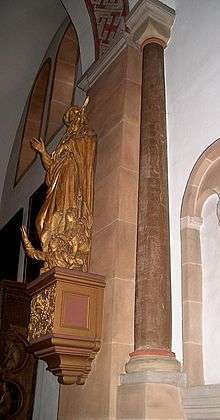Chrysanthus and Daria
Saints Chrysanthus and Daria (3rd century – c. 283) are saints of the Early Christian period. Their names appear in the Martyrologium Hieronymianum, an early martyrs list, and a church was built in their honour over their reputed burial place in Rome.
Saints Chrysanthus and Daria | |
|---|---|
 The martyrdom of Sts Chrysanthus and Daria. From a 14th-century manuscript | |
| Martyrs | |
| Born | 3rd century AD Rome, Roman Empire |
| Died | c. 283 Rome |
| Venerated in | Eastern Orthodox Churches Oriental Orthodox Churches Roman Catholic Church |
| Canonized | Pre-Congregation |
| Feast | October 25 (Western Christianity) March 19 (Eastern Christianity) |

Legend
Acts of the Martyrs relating the legend of Chrysanthus and Daria exist in a Greek and in Latin versions, dating from the fifth century and all "without historical value", according to Johann Peter Kirsch, writing in the Catholic Encyclopedia.[1]
According to legend, Chrysanthus was the only son of an Egyptian patrician, named Polemius or Poleon, who lived during the reign of Numerian. His father moved from Alexandria to Rome. Chrysanthus was educated in the finest manner of the era. Disenchanted with the excess in the Roman world, he began reading the Acts of the Apostles.[2]
He was then baptized and educated in Christian thinking by a priest named Carpophorus. His father was unhappy with Chrysanthus's conversion and attempted to inculcate secular ways into his son by arranging a marriage to Daria, a Roman priestess of Minerva.[2] (Other accounts state that she was a Vestal Virgin.)[3] Chrysanthus managed to convert his wife, and the couple agreed to lead celibate lives. They went on to convert a number of Romans.
When this was made known to Claudius, the tribune, Chrysanthus was arrested and tortured. Chrysanthus's faith and fortitude under torture were so impressive to Claudius that he and his wife, Hilaria, two sons named Maurus and Jason, and seventy of his soldiers became Christians. For this betrayal, the emperor had Claudius drowned, his sons beheaded and his wife went to the gallows. The legend states that Daria was sent to live as a prostitute, but her chastity was defended by a lioness. She was brought before Numerian and ordered to be executed. There are many variations to this legend. Some claim that she was subjected to execution by stoning, others say she was beheaded and yet others claim she was buried alive in a deep pit beside her husband. It appears this torment was chosen in order to inflict on Daria the death reserved for unfaithful vestals.[4] They were entombed in a sand pit near the Via Salaria Nova, the catacombs in Rome.[1]
The surviving "Acts" of Chrysanthus and Daria state that on the anniversary of their deaths, a large number of Christians had gathered at their underground crypt to pay their respects when Roman persecutors surprised them, filled the crypt with stones and buried them all alive, including Diodorus, a priest, and Marianus, a deacon.[1]
Historical notes
Numerian was never in Rome.[3] The Romans would not have sent a Vestal virgin, who was supposed to be the keeper of Rome's fortunes and for whom it was imperative to remain a virgin, into a whorehouse. Candida Moss states "this simply could not have happened...whoever composed this story lived during a period when people no longer understood how important vestals were."[3]
Relics
At least three places claim to possess the remains of Chrysanthus and Daria. In the ninth century, their reputed remains were brought to Prüm in modern-day Rhineland-Palatinate, and these relics are presently in the church of Chrysanthus and Daria, Bad Münstereifel, Germany.[5] In 1011, Pope Sergius IV gave Fulk III, Count of Anjou, the reputed bodies of Chrysanthus and Daria upon his return from a pilgrimage to Jerusalem. Fulk gave them to the monastery of Belli Locus (now Beaulieu-lès-Loches), which he had recently established.[6] The cathedral of Reggio Emilia in northern Italy also contains relics reputed to be those of Daria and Chrysanthus. A scientific study of some of the bones there confirmed that they were those of a young man and a young woman in their late teens, with a radiocarbon date between 80 and 340.[7]
References
- Kirsch, Johann Peter. "Sts. Chrysanthus and Daria". Catholic Encyclopedia, 1908. new advent.org. Retrieved 10 May 2013.

- "Martyr Daria and those with her at Rome", Orthodox Church in America
- Moss, Candida (2013). The Myth of Persecution. HarperCollins. p. 86. ISBN 978-0-06-210452-6.
- Guerin, Paul. "Saint Chrysanthus and Saint Daria", Les Petits Bollandistes: Vies des Saints, (Bloud et Barral: Paris, 1882), Vol. 12

- "Travel guide to Bad Münstereifel". Guide to Germany. Eupedia.com. Retrieved 10 May 2013.
- Bachrach, Bernard S. (1993). Fulk Nerra, the Neo-Roman Consul 987-1040: A Political Biography of the Angevin Count. University of California Press. p. 125. ISBN 978-0520079960.
- "Legendary Saints Were Real, Buried Alive, Study Hints". National Geographic News. Retrieved 10 May 2013.
![]()
External links
| Wikimedia Commons has media related to Saints Chrysanthus and Daria. |
- Patron Saints Index: Sts. Chrysanthus and Daria
- Holy Protection Russian Orthodox Church
- Holy Martyrs Chrysanthus and Daria in Orthodoxy
- Selected Lives of Saints
- The Two Lovers of Heaven: Chrysanthus and Daria at Project Gutenberg. A drama of early Christian Rome by Pedro Calderón de la Barca, translated by Denis Florence MacCarthy.
